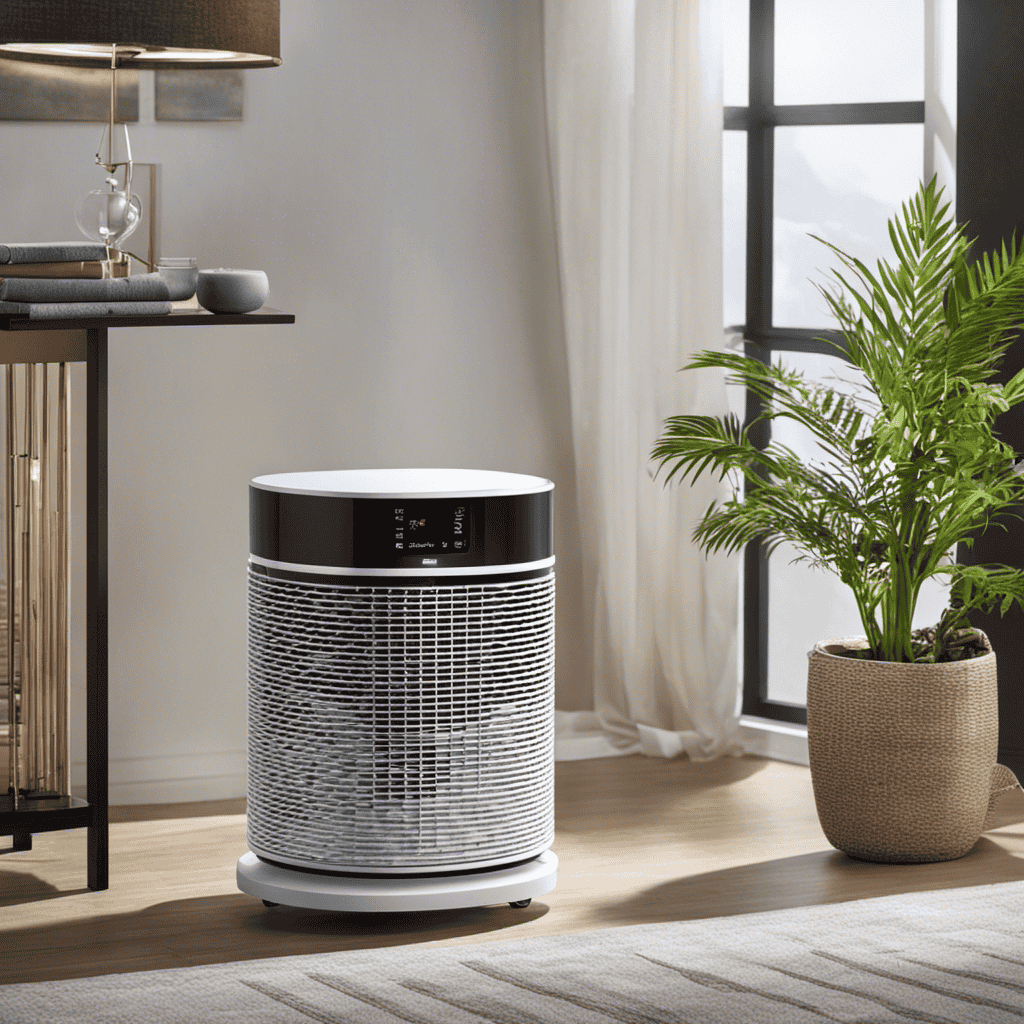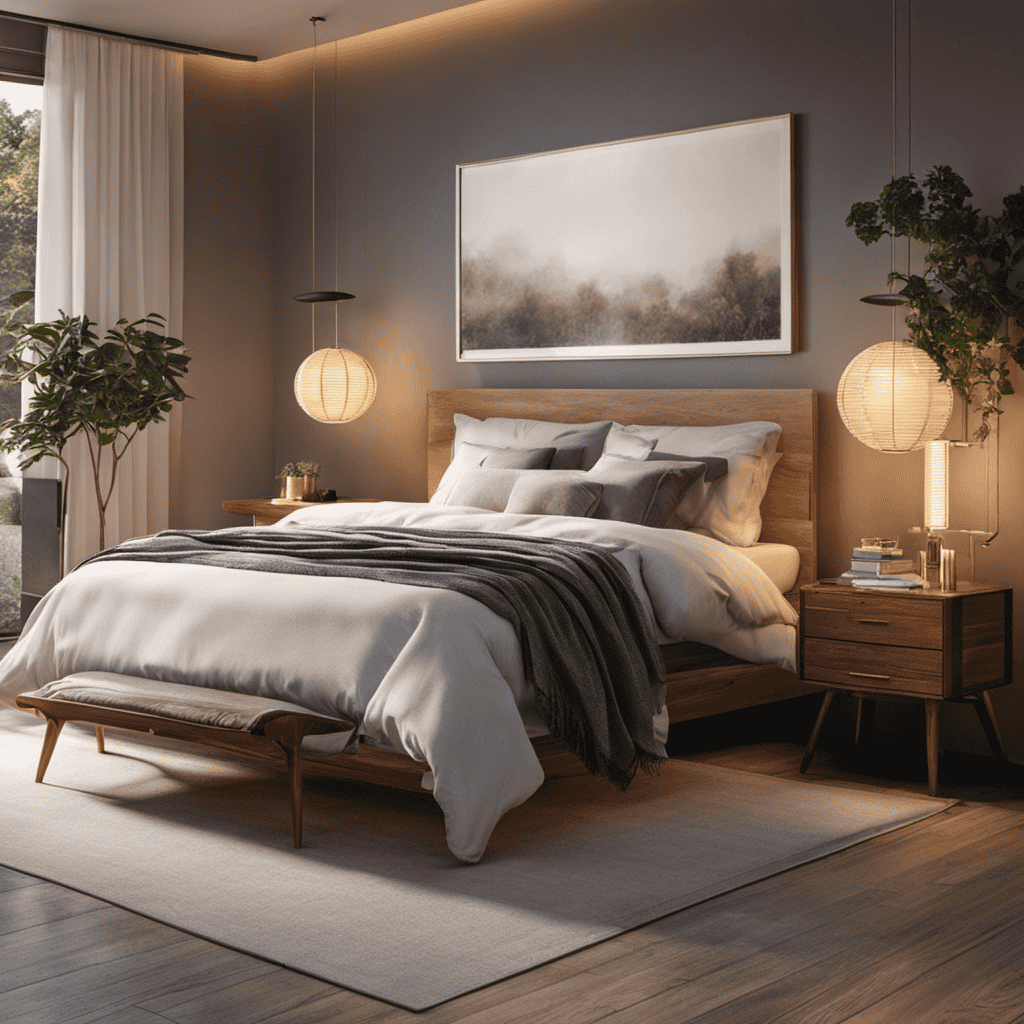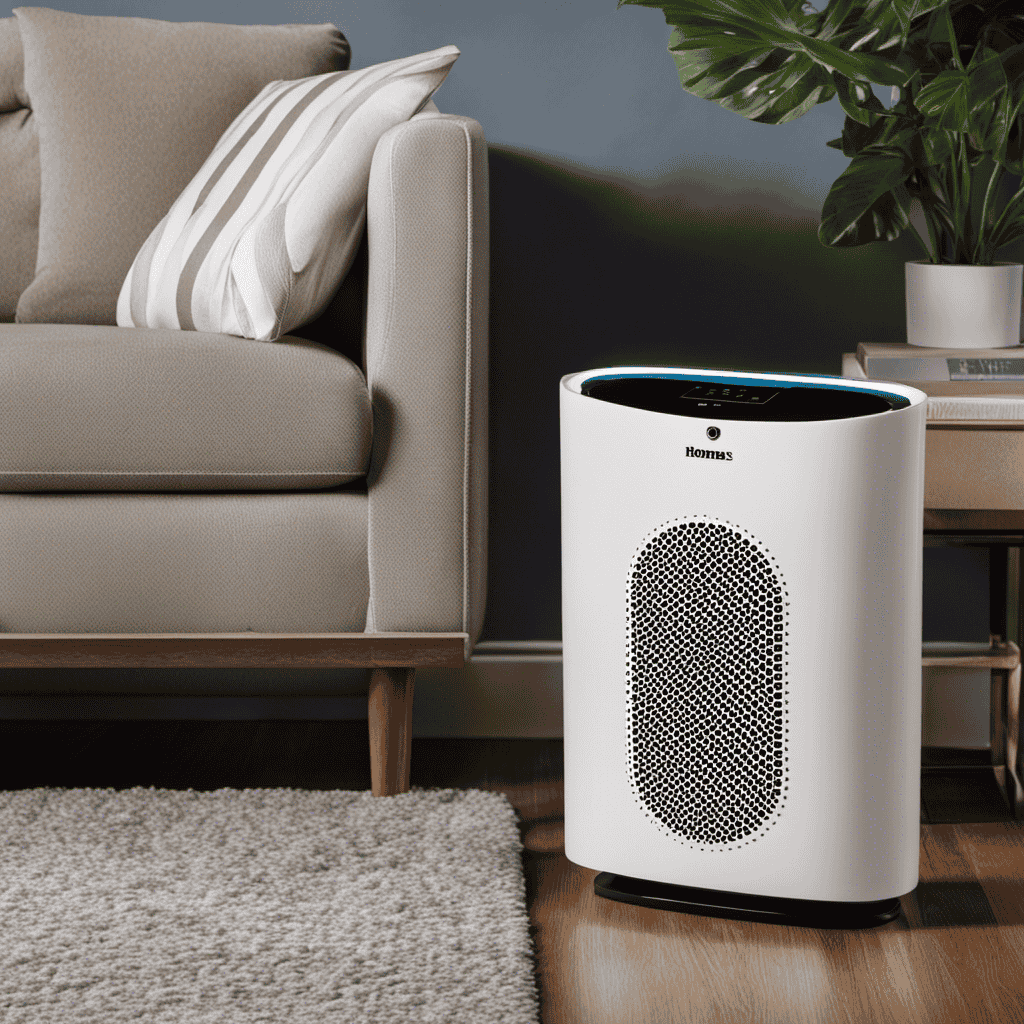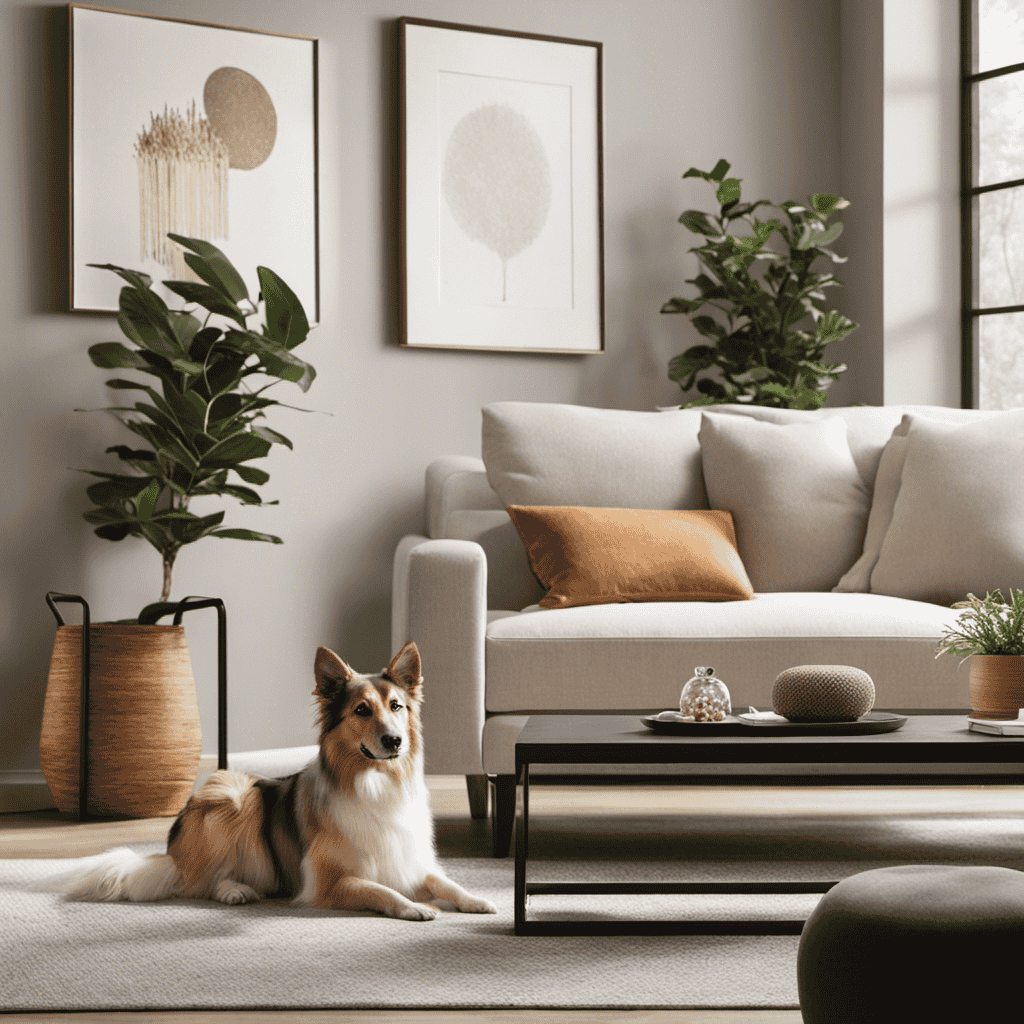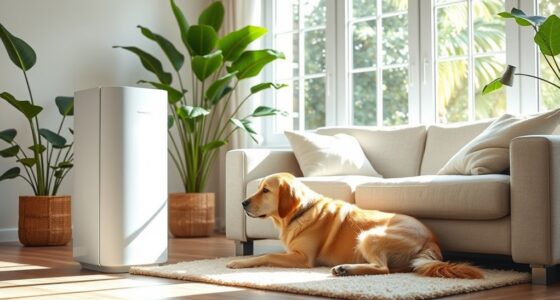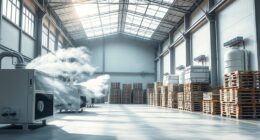Did you know that indoor air can be up to five times more polluted than outdoor air? This alarming statistic underscores the necessity of owning an air purifier.
In this article, I will explain how an air purifier works, the different types available, and the filtration processes they use to remove pollutants. From HEPA filters to UV-C light technology, we’ll explore the inner workings of these devices and how they can help improve the air quality in your home.
Key Takeaways
- Air purifiers improve indoor air quality by removing pollutants and allergens.
- Different types of filters, such as HEPA filters and activated carbon filters, are used to capture and eliminate contaminants.
- Air purifiers use a filtration process that includes pre-filters, HEPA filters, activated carbon filters, and UV-C light to clean the air.
- Negative ions in air purifiers play a crucial role in air ionization and help clean the air we breathe.
Types of Air Purifiers
There are several types of air purifiers available on the market. Air purifiers are beneficial for improving indoor air quality by removing pollutants and allergens from the air.
Different types of filters are used in air purifiers to capture and eliminate these contaminants. One common type of filter is the HEPA (High-Efficiency Particulate Air) filter. It can effectively trap particles as small as 0.3 microns, including dust, pollen, pet dander, and mold spores.
Another type of filter is the activated carbon filter, which is effective in removing odors, chemicals, and volatile organic compounds (VOCs) from the air.
Additionally, some air purifiers use electrostatic filters, which charge particles and attract them to a collection plate.
Filtration Process
The filtration process in an air purifier involves trapping and removing particles from the air. This process is crucial for improving the air quality in our living spaces.
Here’s how an air purifier efficiently cleans the air:
-
Pre-filters: These capture large particles like dust and hair, extending the lifespan of the main filter.
-
HEPA filter: High Efficiency Particulate Air (HEPA) filters remove 99.97% of airborne particles as small as 0.3 microns, including allergens, pollen, and pet dander.
-
Activated carbon filter: This filter eliminates odors, gases, and volatile organic compounds (VOCs), creating a fresher environment.
-
UV-C light: Some air purifiers use UV-C light to kill germs, bacteria, and viruses, ensuring a healthier respiratory system.
By effectively removing harmful pollutants and allergens, air purifiers not only enhance indoor air quality but also provide numerous benefits for our health, including reduced allergies, improved sleep, and enhanced respiratory function.
Enjoying clean air is vital for our overall well-being.
HEPA Filters Explained
To understand how HEPA filters work in an air purifier, imagine tiny particles being captured and removed from the air, ensuring cleaner and healthier indoor environments.
HEPA, or High Efficiency Particulate Air, filters are designed to trap particles as small as 0.3 microns. These filters are made up of a dense mat of fibers that create a maze-like structure, allowing air to pass through while capturing harmful particles.
The benefits of HEPA filters are immense; they can remove up to 99.97% of airborne pollutants such as pollen, dust mites, pet dander, and even bacteria and viruses. However, to maintain their effectiveness, regular maintenance is crucial.
This includes replacing the filters as recommended by the manufacturer and vacuuming or washing them to remove accumulated debris. By properly maintaining HEPA filters, you can ensure that your air purifier continues to provide clean and healthy air for you and your family.
Activated Carbon Filters
Activated carbon filters in an air purifier efficiently trap and remove odors, chemicals, and volatile organic compounds, improving the overall air quality in your home. These filters have several benefits, including absorbing and neutralizing unpleasant odors, such as cooking smells or pet odors. They also remove harmful chemicals and gases, such as formaldehyde and benzene, that can be emitted from furniture or cleaning products. Additionally, they capture volatile organic compounds (VOCs), which are released by paints, solvents, and adhesives and can cause respiratory irritation. Another advantage of activated carbon filters is that they extend the lifespan of the air purifier by preventing larger particles from clogging the HEPA filter.
To ensure optimal performance, regular maintenance of activated carbon filters is essential. This includes replacing the filter when it becomes saturated, typically every 6 to 12 months, depending on usage and air quality. Some air purifiers also have indicator lights that signal when the filter needs to be replaced. By properly maintaining your activated carbon filter, you can continue to enjoy clean and fresh air in your home.
Now, let’s delve into the next topic: UV-C light technology.
UV-C Light Technology
UV-C light technology uses ultraviolet light to kill or inactivate microorganisms like bacteria, viruses, and mold spores in the air. This technology works by emitting short-wavelength UV-C light, which damages the DNA and RNA of these microorganisms, preventing them from reproducing and causing harm.
UV-C light disinfection has several benefits. Firstly, it is a chemical-free and non-toxic method of disinfection, making it safe for use in various environments, including homes, hospitals, and laboratories.
Secondly, UV-C light technology is highly effective, with studies showing that it can eliminate up to 99.9% of airborne microorganisms.
Additionally, this technology is easy to use and maintain, requiring minimal effort and resources.
Overall, UV-C light technology offers a powerful and convenient solution for improving indoor air quality and reducing the risk of airborne infections.
Ionizers and Negative Ions
When it comes to air purification, understanding the benefits of ionizers and negative ions is crucial.
Ionizers are devices that release negative ions into the air, which attach to and remove pollutants. These negative ions have been shown to improve air quality and potentially have positive effects on mood and overall well-being.
However, it is important to note that ionizers and negative ions are not the same thing. Ionizers are the devices that produce negative ions, while negative ions are the particles themselves.
Ionizer Benefits Explained
You’ll appreciate the benefits of an ionizer in an air purifier. An ionizer is a key component of air purifier technology that enhances the overall effectiveness of the device. Here are some benefits of an ionizer:
-
Removes airborne particles: An ionizer releases negatively charged ions into the air, which attach to and neutralize positively charged particles like dust, pollen, and pet dander.
-
Eliminates odors: The ionization process breaks down odorous molecules, effectively removing unpleasant smells from the air.
-
Reduces bacteria and viruses: Negative ions emitted by the ionizer can help to deactivate harmful microorganisms, reducing the risk of illness.
-
Enhances air quality: By improving the overall air quality, an ionizer can help alleviate symptoms of allergies, asthma, and other respiratory conditions.
With these benefits, incorporating an ionizer into an air purifier ensures a cleaner and healthier indoor environment.
Now, let’s delve into the science behind negative ions and how they contribute to the air purification process.
Negative Ions Explained
In my previous subtopic, I discussed the benefits of ionizers in air purifiers. Now, let’s delve into the concept of negative ions and how they contribute to air purification. Negative ions are molecules that have gained an extra electron, creating a negatively charged particle. These ions play a crucial role in air ionization, a process that helps to clean the air we breathe. When released into the atmosphere, negative ions attach themselves to airborne particles, such as dust, pollen, and smoke. This causes the particles to become negatively charged and clump together, making them heavier and easier to be captured by the air purifier’s filtration system. To better understand the effects of negative ions, let’s take a look at the following table:
| Positive Ions | Negative Ions | Air Ionization |
|---|---|---|
| Attracts dust and pollutants | Attaches to airborne particles | Cleans the air |
| Can cause respiratory issues | Promotes a sense of well-being | Improves air quality |
| Increases static electricity | Reduces static electricity | Enhances overall environment |
| Can lead to fatigue and allergies | Boosts energy levels | Creates a healthier atmosphere |
| Creates an imbalance in the air | Restores balance in the air | Creates a more harmonious space |
Ionizer Vs. Negative Ions
The difference between an ionizer and negative ions is that an ionizer emits positive ions, while negative ions attach to airborne particles.
Air ionizers are devices that release positive ions into the air to neutralize and remove harmful pollutants. They work by attracting and capturing airborne particles, such as dust, pollen, and pet dander, onto their charged plates or filters. This helps to improve the overall air quality in a room or space.
Some health benefits of using air ionizers include:
- Reduction of allergens: Air ionizers can effectively remove allergens from the air, providing relief to individuals with allergies or asthma.
- Improved respiratory health: By removing airborne particles, air ionizers can help to reduce respiratory symptoms and improve breathing.
- Enhanced mood and well-being: Negative ions released by air ionizers have been linked to increased serotonin levels, which can promote a sense of well-being and improve mood.
- Odor elimination: Air ionizers can help to eliminate unpleasant odors by neutralizing the charged particles that cause them.
Overall, air ionizers can be a valuable addition to any indoor space, providing health benefits and improving air quality.
Ozone Generators
Ozone generators work by producing ozone, which is a form of oxygen that can help remove odors and kill bacteria in the air. Ozone is a powerful oxidizer that breaks down pollutants, such as volatile organic compounds (VOCs), and neutralizes them.
However, it is important to note that ozone generators can also contribute to ozone pollution and ozone depletion. Ozone pollution occurs when ozone is present at ground level, causing respiratory problems and other health issues. Ozone depletion refers to the thinning of the ozone layer in the Earth’s stratosphere, which protects us from harmful ultraviolet (UV) rays.
Therefore, it is crucial to use ozone generators responsibly and follow safety guidelines to minimize any negative impact.
Now, let’s explore the differences between air purifiers and air filters.
Air Purifiers Vs. Air Filters
Now that we have discussed ozone generators, let’s move on to the comparison between air purifiers and air filters.
Air purifiers and air filters are both commonly used to improve indoor air quality. However, they work in different ways and offer varying benefits.
Here are some key points to consider:
-
Air purifiers utilize advanced technologies, such as HEPA filters, activated carbon filters, and UV-C lights, to capture and eliminate airborne pollutants.
-
Air purifiers can effectively remove particles as small as 0.3 microns, including dust, pollen, pet dander, mold spores, and even some bacteria and viruses.
-
Air filters, on the other hand, primarily work by trapping larger particles in a filter media, such as fiberglass or pleated paper.
-
While air filters can help improve air quality, they are generally less effective at capturing smaller particles and may require more frequent replacement.
Benefits of Using an Air Purifier
One of the main advantages of using an air purifier is that it effectively removes airborne pollutants, such as dust, pollen, and pet dander. Air purifiers work by using filters to capture and trap these pollutants, preventing them from circulating in the air.
However, it is important to note that regular maintenance is necessary to ensure the optimal performance of the air purifier. This includes cleaning or replacing the filters regularly and keeping the unit free from dust and debris.
When choosing the right air purifier, factors such as the size of the room, the type of pollutants you want to remove, and the noise levels should be considered. By properly maintaining and selecting the right air purifier, you can create a clean and healthy indoor environment.
Now, let’s explore some common indoor air pollutants.
Common Indoor Air Pollutants
When it comes to discussing common indoor air pollutants, it’s important to understand both their sources and the potential health effects they can have.
Harmful pollutant sources can include various household items such as cleaning products, tobacco smoke, and even certain types of furniture.
These pollutants can lead to respiratory issues, allergies, and even more serious health conditions if not properly addressed and removed from the indoor environment.
Harmful Pollutant Sources
To understand how an air purifier works, you should identify the sources of harmful pollutants in your environment. These pollutants can come from various sources such as outdoor pollution, indoor activities, building materials, and mold and mildew.
- Outdoor pollution: Industrial emissions, vehicle exhaust, and pollen can infiltrate your indoor space.
- Indoor activities: Cooking, smoking, and using certain household products can release pollutants into the air.
- Building materials: Some building materials, such as paints, carpets, and furniture, can emit harmful chemicals.
- Mold and mildew: Damp areas in your home can promote the growth of mold and mildew, releasing spores into the air.
Identifying these sources is crucial because air purifiers target specific pollutants based on their filtration systems. By understanding the sources of pollutants, you can choose an air purifier that effectively removes the harmful particles from your environment.
Now let’s explore the health effects of these pollutants.
Health Effects of Pollutants?
Understanding the health effects of pollutants is essential for your well-being and making informed choices to improve the quality of your indoor air.
Long term exposure to indoor pollution can have detrimental effects on your health. Indoor pollutants such as tobacco smoke, mold, dust mites, pet dander, and volatile organic compounds (VOCs) can lead to respiratory problems like asthma and allergies. These pollutants can also trigger symptoms in individuals with existing respiratory conditions.
Additionally, long term exposure to indoor pollutants has been linked to an increased risk of developing cardiovascular diseases, lung cancer, and other chronic illnesses.
It is important to take steps to reduce the levels of indoor pollution in your environment, such as using air purifiers, improving ventilation, and regularly cleaning and maintaining your home to minimize the health risks associated with these pollutants.
Dust and Allergens Removal
If you’re dealing with dust and allergens, an air purifier can help by filtering them out of the air you breathe. Here’s how it works:
-
HEPA Filter: The air purifier uses a High-Efficiency Particulate Air (HEPA) filter to trap tiny particles like dust mites, pollen, pet dander, and mold spores.
-
Activated Carbon Filter: It also has an activated carbon filter that absorbs odors, chemicals, and volatile organic compounds (VOCs).
-
UV-C Light: Some air purifiers have UV-C light technology that can kill airborne germs and bacteria.
-
Ionizer: Another feature is an ionizer, which releases negatively charged ions that attach to positively charged particles, making them heavier and causing them to fall out of the air.
Pet Dander and Odor Elimination
When it comes to effectively removing pet dander from the air, there are key filtration techniques that can be employed.
These techniques include the use of HEPA filters, which are designed to trap even the smallest particles, such as pet dander.
Additionally, activated carbon filters can help neutralize and eliminate pet odors, ensuring a more pleasant and fresh-smelling environment.
Effective Pet Dander Filtration
To effectively filter out pet dander from the air, you’ll want to make sure your air purifier has a HEPA filter. This high-efficiency particulate air filter is designed to capture tiny particles, including pet dander, and prevent them from recirculating in your home.
Here are some key features to consider when choosing an air purifier for pet dander control and pet allergies relief:
-
HEPA Filter: Look for an air purifier with a true HEPA filter, which can trap particles as small as 0.3 microns in size.
-
Activated Carbon Filter: This filter helps remove odors associated with pets, such as urine or litter box smells.
-
Pre-Filter: A pre-filter captures larger particles like pet hair and dust, extending the life of the HEPA filter.
-
Air Exchange Rate: Consider the air exchange rate, which indicates how quickly the purifier can clean the air in a room.
Odor Neutralization Techniques
One effective way to neutralize odors caused by pets is by using activated carbon filters in your air purifier.
Activated carbon is a highly porous material that has the ability to trap and remove odorous molecules from the air. When air passes through the carbon filter, the activated carbon adsorbs the odor-causing compounds, preventing them from being released back into the air.
This process, known as adsorption, is highly effective in removing a wide range of pet odors, including those from urine, feces, and dander. The activated carbon filters in air purifiers are designed to have a large surface area, allowing for maximum odor elimination.
Regularly replacing the carbon filters is crucial to ensure their efficiency in pet odor removal. By incorporating activated carbon filters into your air purifier, you can effectively eliminate pet odors and improve the overall air quality in your home.
Mold and Mildew Prevention
If you want to prevent mold and mildew, you should consider using an air purifier. Air purifiers are effective at removing mold spores from the air, reducing the risk of mold growth in your home. Here’s how an air purifier can help with mold prevention:
-
Filtration: Air purifiers use high-efficiency particulate air (HEPA) filters to trap mold spores and prevent them from circulating in the air.
-
Humidity control: Some air purifiers are equipped with built-in humidifiers or dehumidifiers to help maintain optimal humidity levels in your home, making it less favorable for mold growth.
-
UV-C light: Certain air purifiers utilize ultraviolet (UV-C) light to kill mold spores and other microorganisms, providing an additional layer of protection against mold.
-
Activated carbon filters: Air purifiers with activated carbon filters can help eliminate musty odors often associated with mold and mildew.
Vocs and Chemical Filtration
When it comes to improving indoor air quality, one of the key points to consider is the removal of harmful indoor pollutants.
These pollutants can include volatile organic compounds (VOCs), which are released from various sources such as paints, cleaning products, and furniture.
Harmful Indoor Pollutants
You should be aware that harmful indoor pollutants such as dust, pollen, and pet dander can negatively affect your indoor air quality. To maintain a healthy indoor environment and protect your respiratory health, it is essential to understand the potential sources of these pollutants.
Here are some common indoor pollutants to watch out for:
- Dust: Tiny particles that can accumulate on surfaces and float in the air.
- Pollen: Fine powdery substance released by plants that can trigger allergies.
- Pet dander: Tiny flecks of skin shed by pets that can cause allergic reactions.
- Mold spores: Microscopic reproductive cells of mold that can grow in damp areas.
These pollutants can aggravate respiratory conditions, such as asthma or allergies. Investing in an air purifier can help remove these harmful particles from the air, improving your indoor air quality and promoting better respiratory health.
Air Quality Improvement
Improving indoor air quality can be achieved by using an air purifier to remove harmful pollutants. Air purifiers are devices designed to filter the air and remove contaminants such as dust, pollen, pet dander, mold spores, and even certain bacteria and viruses.
By removing these pollutants, air purifiers can provide numerous benefits to our health and well-being. Breathing clean air can reduce respiratory issues, alleviate allergy symptoms, and improve overall respiratory health.
Additionally, air purifiers can help eliminate unpleasant odors and create a more pleasant and comfortable living environment. The importance of air purification cannot be overstated, especially in today’s world where indoor air pollution is a growing concern.
With the aid of an air purifier, we can ensure that the air we breathe is clean and healthy. As such, it is crucial to properly maintain and care for our air purifiers to ensure their optimal performance and longevity.
Maintenance and Care Tips
To keep your air purifier functioning effectively, it’s important to regularly clean or replace the filters. The filters are crucial for trapping and removing airborne particles, such as dust, pollen, and pet dander. Neglecting to maintain your air purifier can result in reduced efficiency and poor air quality.
Follow these maintenance and care tips to ensure optimal performance:
-
Check the filter indicator: Most air purifiers have a filter replacement indicator that alerts you when it’s time to change the filters.
-
Clean the pre-filter: The pre-filter captures larger particles and should be cleaned regularly to prevent clogging.
-
Vacuum the exterior: Dust and debris can accumulate on the exterior of the air purifier, so give it a thorough vacuuming to keep it clean.
-
Replace filters as recommended: Different types of filters have different lifespans, so make sure to replace them according to the manufacturer’s instructions.
Frequently Asked Questions
Can an Air Purifier Completely Eliminate All Indoor Air Pollutants?
No, an air purifier cannot completely eliminate all indoor air pollutants. While it can be effective in reducing them, regular maintenance is necessary to ensure optimal performance and to remove accumulated particles.
How Long Does It Take for an Air Purifier to Clean the Air in a Room?
It typically takes a few hours for an air purifier to clean the air in a room. However, this can vary depending on the size of the room, the effectiveness of the air purifier, and how well it is maintained.
Can an Air Purifier Help With Respiratory Conditions Such as Asthma or Allergies?
Yes, an air purifier can help with respiratory conditions like asthma or allergies. It improves indoor air quality by removing allergens and irritants. Regular maintenance, such as changing filters, is necessary for optimal air purifier effectiveness.
Are There Any Side Effects or Health Risks Associated With Using an Air Purifier?
There can be some side effects or health risks associated with using an air purifier. These may include dryness of the skin and throat, increased allergies due to ineffective filtration, and the need for regular maintenance. The noise level and energy consumption can also be factors to consider.
Can an Air Purifier Remove Cigarette Smoke and Its Odor From a Room?
Yes, an air purifier can remove cigarette smoke and its odor from a room. Regular air purifier maintenance, such as changing filters, is important. There are different types of air purifiers, such as HEPA filters, that are effective in removing smoke particles.
Conclusion
In conclusion, air purifiers are a game-changer when it comes to improving indoor air quality. They work tirelessly to filter out harmful particles and eliminate unpleasant odors, providing a breath of fresh air for you and your loved ones.
With various types of air purifiers available, such as HEPA filters and activated carbon filters, you can choose the one that suits your needs best. Remember, prevention is better than cure, so investing in an air purifier is like having an ace up your sleeve in the battle against indoor pollutants.
Trust me, when it comes to clean air, an air purifier is worth its weight in gold.
